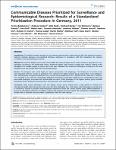Communicable Diseases Prioritized for Surveillance and Epidemiological Research: Results of a Standardized Prioritization Procedure in Germany, 2011
Balabanova, Yanina
Gilsdorf, Andreas
Buda, Silke
Burger, Reinhard
Eckmanns, Tim
Gärtner, Barbara
Groß, Uwe
Haas, Walter
Hamouda, Osamah
Hübner, Johannes
Jänisch, Thomas
Kist, Manfred
Kramer, Michael H.
Ledig, Thomas
Mielke, Martin
Pulz, Matthias
Stark, Klaus
Suttorp, Norbert
Ulbrich, Uta
Wichmann, Ole
Krause, Gérard
Introduction: To establish strategic priorities for the German national public health institute (RKI) and guide the institute’s mid-term strategic decisions, we prioritized infectious pathogens in accordance with their importance for national surveillance and epidemiological research. Methods: We used the Delphi process with internal (RKI) and external experts and a metric-consensus approach to score pathogens according to ten three-tiered criteria. Additional experts were invited to weight each criterion, leading to the calculation of a median weight by which each score was multiplied. We ranked the pathogens according to the total weighted score and divided them into four priority groups. Results: 127 pathogens were scored. Eighty-six experts participated in the weighting; ‘‘Case fatality rate’’ was rated as the most important criterion. Twenty-six pathogens were ranked in the highest priority group; among those were pathogens with internationally recognised importance (e.g., Human Immunodeficiency Virus, Mycobacterium tuberculosis, Influenza virus, Hepatitis C virus, Neisseria meningitides), pathogens frequently causing large outbreaks (e.g., Campylobacter spp.), and nosocomial pathogens associated with antimicrobial resistance. Other pathogens in the highest priority group included Helicobacter pylori, Respiratory Syncytial Virus, Varicella zoster virus and Hantavirus. Discussion: While several pathogens from the highest priority group already have a high profile in national and international health policy documents, high scores for other pathogens (e.g., Helicobacter pylori, Respiratory syncytial virus or Hantavirus) indicate a possible under-recognised importance within the current German public health framework. A process to strengthen respective surveillance systems and research has been started. The prioritization methodology has worked well; its modular structure makes it potentially useful for other settings.
Dateien zu dieser Publikation
Keine Lizenzangabe

